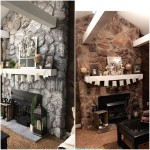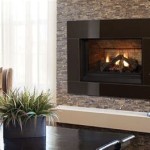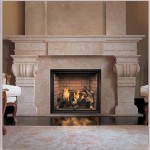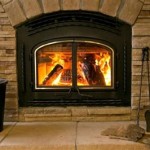Gas Fireplace Rock: A Comprehensive Guide
Gas fireplaces offer a convenient and aesthetically pleasing alternative to traditional wood-burning fireplaces. A crucial element of the gas fireplace’s visual appeal is the material used to mimic the look of a natural wood fire. While ceramic logs are a common choice, gas fireplace rock presents a distinctive and increasingly popular option. These rocks, often made from ceramic or other heat-resistant materials, contribute significantly to the ambiance and realism of the gas fireplace. This article provides a comprehensive overview of gas fireplace rock, covering its types, benefits, installation, maintenance, and safety considerations.
Types of Gas Fireplace Rock
Gas fireplace rock is available in a variety of materials, shapes, and colors, allowing homeowners to customize the appearance of their fireplace to suit their individual preferences and the overall décor of their living space. Understanding the different types available is crucial for making an informed decision.
Ceramic Rocks: Ceramic rocks are among the most common types found in gas fireplaces. They are manufactured from a heat-resistant ceramic material designed to withstand the high temperatures produced by the gas flame. Ceramic rocks are available in a wide range of shapes and sizes, mimicking natural rocks found in riverbeds or mountainous regions. They are typically designed to be non-porous and resistant to discoloration or degradation over time. The color options available range from light gray and tan to darker shades of brown and black, offering a natural and realistic appearance.
Lava Rocks: Lava rocks offer a unique aesthetic characterized by their irregular shapes and porous texture. These rocks are often made from volcanic rock or manufactured to resemble volcanic rock. Lava rocks are known for their ability to distribute heat evenly and retain heat, contributing to a more consistent and comfortable warmth emanating from the fireplace. The porous nature of lava rocks can also create a flickering flame effect as the gas burns around the rock’s surface. They generally come in darker shades of gray and black, offering a more rustic and dramatic look.
Glass Rocks: While not strictly "rock" in the traditional sense, glass rocks are a popular alternative for gas fireplaces, offering a modern and contemporary look. These rocks are made from tempered glass, which is specifically designed to withstand high temperatures without shattering or melting. Glass rocks are available in a wide array of colors, including clear, blue, green, red, and even iridescent options. The reflective surface of glass rocks creates a dazzling display as the flames dance around them. They are often used in more modern and minimalist fireplace designs.
River Rocks: River rocks are intended to mimic the smooth, rounded stones found in riverbeds. These rocks are usually made from ceramic or a similar heat-resistant material and are shaped to resemble naturally worn stones. River rocks offer a more subtle and understated aesthetic compared to lava rocks or glass rocks. They typically come in shades of gray, tan, and brown, creating a natural and calming ambiance.
The variety in material type offers different levels of heat retention and reflectivity of light, helping you to achieve the look and feel you desire. It is important to confirm with your fireplace manufacturer's specifications as to which materials are approved for your unit.
Benefits of Using Gas Fireplace Rock
Choosing gas fireplace rock over other options, such as ceramic logs, offers several advantages. These benefits extend beyond purely aesthetic considerations and contribute to the overall performance and maintenance of the fireplace.
Aesthetics and Customization: One of the primary benefits of gas fireplace rock is the enhanced aesthetic appeal it provides. The diverse range of rock types, colors, and shapes allows homeowners to customize the look of their fireplace to match their personal style and the overall décor of their home. Whether they prefer a rustic, modern, or minimalist aesthetic, there is a gas fireplace rock option to suit their needs. Compared to ceramic logs, rocks can often create a more natural and randomly distributed appearance, mimicking the look of a real wood fire.
Heat Distribution: Certain types of gas fireplace rock, particularly lava rocks, are known for their excellent heat distribution properties. The porous nature of lava rocks allows them to absorb and radiate heat evenly, contributing to a more consistent and comfortable warmth throughout the room. This can be particularly beneficial in larger rooms or spaces that require more efficient heating.
Low Maintenance: Gas fireplace rock generally requires minimal maintenance compared to other options. Unlike wood-burning fireplaces, there is no need to clean up ashes or soot. And in comparison to some ceramic logs, rocks are often less prone to soot buildup or discoloration. Regular cleaning with a soft brush or vacuum cleaner may be necessary to remove dust and debris, but this is typically a quick and easy process. Because of the materials they are made from, they are less susceptible to cracking or breaking with normal use.
Lifespan and Durability: High-quality gas fireplace rock is designed to be durable and long-lasting. They are manufactured from heat-resistant materials that can withstand the high temperatures produced by the gas flame without degrading or breaking down over time. This can contribute to a longer lifespan compared to some other decorative options, reducing the need for frequent replacements. Over time, it is natural for some rocks to become discolored or sooty, but this can often be remedied with proper cleaning.
Versatility: Gas fireplace rock can be used in a variety of gas fireplace designs, including vented and ventless models. They are relatively easy to install and can be arranged in different patterns to create unique visual effects. This versatility makes them a suitable option for homeowners seeking to personalize their fireplace and create a distinctive ambiance.
Installation, Maintenance, and Safety
Proper installation, regular maintenance, and adherence to safety precautions are essential for ensuring the safe and efficient operation of a gas fireplace with rock. Following these guidelines will help to extend the lifespan of the fireplace and prevent potential hazards.
Installation: Before installing gas fireplace rock, it is crucial to consult the manufacturer's instructions for the specific fireplace model. These instructions will provide detailed guidance on the proper placement of the rocks and any specific requirements for ventilation or gas flow. It is important to ensure that the rocks are positioned in a way that does not obstruct the gas burner or pilot light. Improper placement can lead to incomplete combustion, carbon monoxide buildup, and other safety hazards. If unsure, consult with a qualified fireplace technician for assistance.
Maintenance: Regular maintenance is essential for keeping the gas fireplace rock clean and free of debris. This can be achieved by periodically brushing or vacuuming the rocks to remove dust, soot, or other particles that may accumulate over time. If the rocks become heavily soiled, they can be carefully removed and washed with a mild detergent and water. Allowing the rocks to dry completely before re-installing them is crucial to prevent moisture damage or other problems.
Safety Considerations: Safety should always be a top priority when operating a gas fireplace. It is important to have the fireplace inspected annually by a qualified technician to ensure that all components are functioning properly and that there are no gas leaks. A carbon monoxide detector should be installed in the vicinity of the fireplace to provide an early warning of any potential carbon monoxide buildup. It's crucial to never place flammable materials near the fireplace and to supervise children and pets while the fireplace is in operation.
Gas Flow and Ventilation: Ensuring proper gas flow and ventilation is critical for the safe and efficient operation of any gas fireplace. The rocks should be arranged in a way that allows for adequate air circulation and prevents the accumulation of unburned gas. For vented fireplaces, make sure that the vent is clear of obstructions and that it is properly connected to the outside. For ventless fireplaces, ensure that there is adequate ventilation in the room to prevent the buildup of carbon monoxide. It is important to understand the specific ventilation requirements for the fireplace model and to adhere to these requirements at all times.
Pilot Light: The pilot light is a small flame that ignites the main gas burner. If the pilot light goes out, it is important to follow the manufacturer's instructions for relighting it. Typically, this involves turning off the gas supply, waiting for a few minutes, and then carefully relighting the pilot light using a long-handled lighter or match. If the pilot light continues to go out repeatedly, it may indicate a problem with the gas supply or the fireplace's control system. It is best to consult with a qualified technician to diagnose and repair the issue.
By carefully considering these factors, homeowners can enjoy the beauty and warmth of a gas fireplace with rock while ensuring safety and optimal performance.

Chaska 34 Rock Kozy Heat Fireplaces

Lava Rock Vs Fire Glass Blog Fireplace And Chimney Authority

Manchester Oak Gas Logs Cyprus Air Fireplaces Va Md Dc

Enviro S Gas C44 Linear Fireplace

River Rock Gas Fireplace Fireplaces

Lava Rock Vs Fire Glass Blog Fireplace And Chimney Authority

Rh Peterson River Rocks For Gas Log Set 5 Mazzeo S Stoves Fireplaces

Logs River Rock Gas Fireplace Accessories For All Styles Glass

Lava Rock Vs Fire Glass Blog Fireplace And Chimney Authority

Gas Fireplace Inserts Heaters Hartford Middletown Indoor
Related Posts








